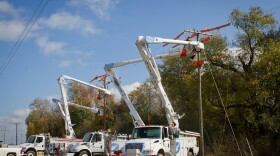Most owls are nocturnal and we're lucky to see them. We usually hear them.
That's the great horned owl with a "Who! Who!" we associate with owls. But these are the other owls in Virginia.
(owl sounds)
That was the Barn, Eastern Screech, and Barred Owl. According to Sabrina Garvin, Executive Director of Southwest Virginia Wildlife Center, those four raptors are not only majestic but vital:
"They're very important. We know that one animal depends on another animal in the food chain… we do need rabbits. We do need squirrels but we don't want them to get in high numbers. So they will keep things in check. :
The diet is slightly different between the four species that live here but common to them all is that they eat rodents. For owls hunting near humans, they are at risk of being poisoned:
"The mice can eat that, run out in the field, down comes the owl, they eat it and it is extremely bad when we've gotten cases of toxin in. Most of them we cannot save if they've gotten into rat poison. Even squirrels will eat it. And they will be out in the field and get sluggish and along comes the hawk or the owl and then it gets in the system it’s a horrible way to die."
Garvin says if we can be patient and allow nature the opportunity to rebound the owls will take care of the rodents for us.
"The screech owls will even cache. And so, they'll take extra and put them in a tree and store them in case they need them for later. They're wonderful exterminators. Nature's exterminator."
Attracting owls to our property is more complicated than attracting birds with a feeder. But, that's a start.
In urban areas, humans get in the way of that cycle. Jessica Ausura is a bird guide, photographer and columnist in Hampton Roads, where the number one threat to most birds is loss of habitat.
If possible, we can attract owls by leaving trees standing, even the dead and dying ones if that's safe. Another thing we can do is leave old silos, barns and out buildings standing for the shelf nesters like Barn Owls. Ausura says we can build houses for owls.
"One of the solutions is to put up nest boxes or provide platforms for snag nesters like great horned owls or barred owls…they build a platform type nest."
Attracting an owl to a particular area takes a lot of work. It's not impossible. And the benefits of creating an owl friendly environment are valuable alone.
Sometimes, like Jess Asura discovered, an owl is attracted to an area where it is not expected:
"That was the appearance of a snowy owl in Norfolk. "
The snowy owl is a beautiful white raptor with a wing span up to to 5 feet and can weigh close to seven pounds, making it one of the heaviest owl species in North America. The one in Norfolk was a long way from home:
"It's normal territory is the Arctic Circle and sometimes there is an over population due to an abundance of food or lack of predation. And so, males and first year off spring will travel farther south. Sometimes it could be a shortage of food or a shift in how much snow there is or weather changes."
The February appearance of the snowy owl got a lot of attention, not only in Virginia but with birders throughout North America. While the owls native to Virginia may not make always make the news, they do make our lives much more interesting.






